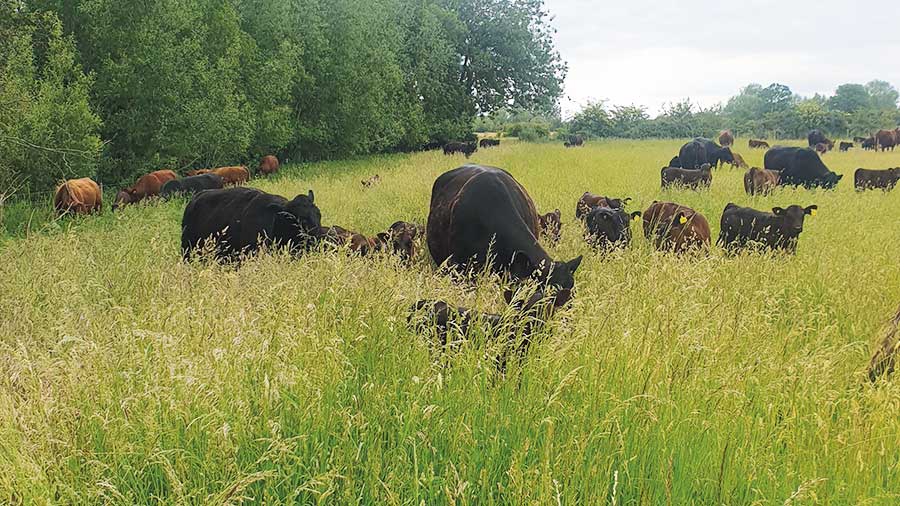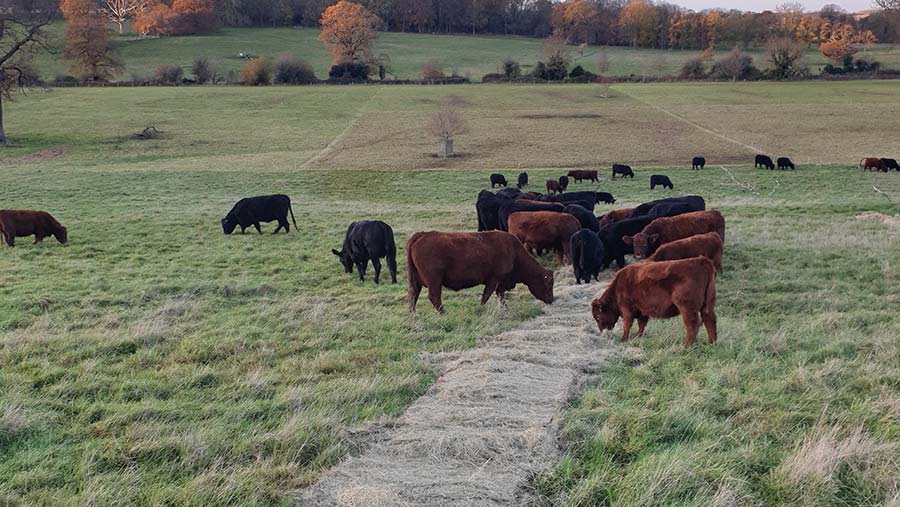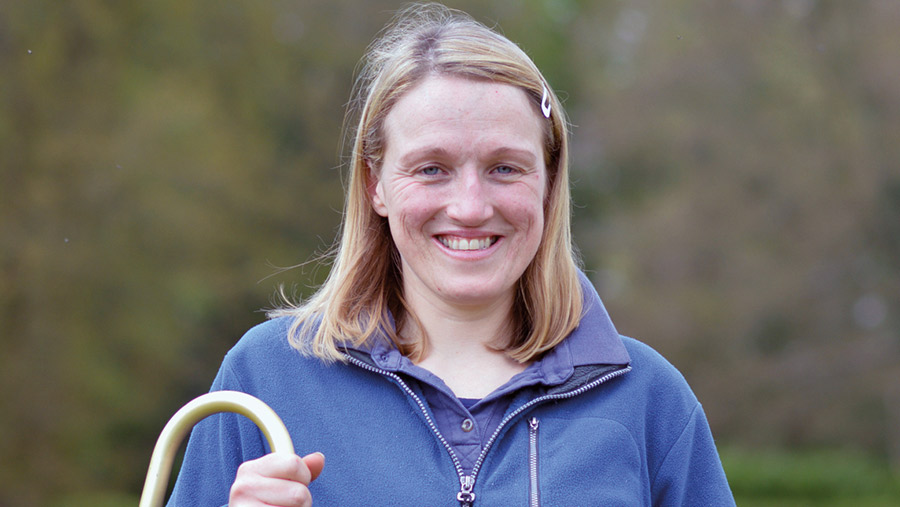How floodplain meadows are central to a regenerative system
 © FAI Farms
© FAI Farms Floodplain meadows are vital for soil and animal health and the hay they produce is more nutritionally and minerally satisfying than standard feed analysis would suggest.
This, is according to Clare Hill, director of regenerative farming at FAI Farms in the Thames valley just outside Oxford.
The floodplain meadows to the north and east of the river are sites of special scientific interest (SSSIs), while those to the south can be grazed more frequently but are less diverse.
Some of these southerly meadows are the result of arable reversion 20 years ago, and some are permanent pasture.
See also: How mixed low-input farming can help grassland biodiversity
“They are all so important for soil health and resilience and ensure [grazing] animals have a really healthy gut biome.”
Farm facts: FAI Farms, Wytham, Oxford
- 486ha (1,200 acres) mixed organic farm rented from Oxford University
- 53ha (130 acres) SSSI floodplain meadows managed for Berks, Bucks and Oxon Wildlife Trust and numerous private individuals
- 93ha (231 acres) other floodplain meadows and permanent pasture
- 90 suckler cows plus followers
- Cows and calves outdoors all year round, followers finished indoors on silage for slaughter at 17-24 months
- Marks & Spencer Select Farm for beef
- 300 breeding ewes
- Sainsbury’s Development Group Farm abattoir and English Farm butchery for lamb
- Arable rotation with herbal leys cut for silage, and oats and a five-grain mix for the farm’s laying hens
Species diversity
The floodplain meadows are not under water every winter, but the water table is high and, even without rain, they are too wet to use for several months of the year.
When flooding recedes, nutrients are left behind. A late hay crop removes the nutrients again, resulting in a balanced cycle that maintains the diversity of species in the meadows.
Grazing the aftermath is also important for encouraging diversity – a point borne out by long-term monitoring of one of the meadows on the farm by Alison McDonald of Oxford University.
Dr McDonald made a comparative study of Somerford Mead, which was ploughed for the first time in 1981, restored a few years later using seed from a nearby meadow, and managed under different grazing treatments.
She found that, while grazing the aftermath with cattle produced a slightly more species-rich sward in some years than plots grazed by sheep, both treatments were richer than the ungrazed plots.
Benefits of diversity
“I used to write the floodplain meadows off as a scrubby old mess,” says Mrs Hill.
“Now I really appreciate their value. Every species adds a new element to the soil, with root exudates feeding soil microbes, which in turn feed protozoa, which are eaten by earthworms, which provide food for predators.
The varying rooting depths of the plant species draw up minerals from different levels in the soil, she adds.
“It’s great to graze [these meadows] and make hay from them, which we use for bale-grazing elsewhere on the farm. It’s like mineral rocket fuel.”
Last year, the hay averaged 77.9% dry matter (DM). A 700kg lactating cow with a six-month-old calf would need to eat 2.5% of her bodyweight, or 17.5kg DM/day.
Yet the suckler cows on the farm – Salers, with some Angus and Stabiliser genes – seem to thrive on much less.
“It’s at this stage of lactation that we start bale-grazing using the species-rich floodplain hay, and we find that they only eat 10kg DM/day while feeding a calf and maintaining or gaining condition,” says Mrs Hill.

© FAI Farms
Grassland management
Management has changed from set-stocking to adaptive multi-paddock grazing. Rest periods are key. “The SSSIs have taught us about species diversity, and how longer rest periods allow slower-growing species in the seed bank to thrive,” she says.
These meadows are rested for eight months of the year, after a hay cut in July and a short aftermath graze by sheep in the autumn.
“We are not replicating this entirely on our non-SSSI floodplain meadows, but we are extending rest periods as part of our adaptive multi-paddock grazing.
“Where a field would benefit from longer rest, we give it six months; in the growing season on some fields, we aim for 60 days, and sometimes it’s 45 days.”
Hay from the floodplain meadows is transported directly to these fields and rolled out for the outwintering cattle.
“Some seed inevitably falls back into the meadows during haymaking, but some gets carried in the hay, and birds eat some, so we are populating other areas of the farm with [different] species,” she says.

Clare Hill © Ben Pike
While hay is the main forage produced, silage is made from herbal leys grown as part of the arable rotation and used as a finishing ration for the cattle indoors. The sheep are also brought in for one to two months towards the end of winter to rest the grass and break the worm cycle.
Networking
Mrs Hill has linked up with other managers of floodplain meadows, particularly her neighbours.
“I’m not an expert, I’m definitely just learning and interested in the diversity [the meadows bring] to the farm. Until two years ago, I would have been dismissive. I’ve done a complete 360 on it,” she says.
Clare Hill’s top tips for floodplain meadow management
- Consider redefining productivity – rather than thinking of floodplain meadows as scrubby and unproductive because they are not full of rye grass and clover, think of them as mineral-rich, like a free bolus
- Join up with other farmers who manage floodplains along your river and see how they are managing them
- Look at Countryside Stewardship options for improved management of floodplains
- Think about public money for public goods under the new Environmental Land Management scheme. Managing your soil to improve its water-holding capacity, to keep as much water upstream as possible, is good for productivity and protects homes downstream from flooding.
Floodplain meadows – the basics
What are floodplain meadows?
Areas of grassland that are seasonally flooded by a nearby watercourse or with a plentiful groundwater supply through gravel or sand aquifers.
Typically, soil type is nutrient-rich silt over gravel or, less frequently, peat.
They are managed by taking a late hay cut and grazing the aftermath.
Why have most of them disappeared?
- Agricultural intensification
- Sand and gravel extraction
- Urban and industrial development
- Hydrological changes to river floodplains.
Although re-creation of some meadows and reinstatement of traditional management have helped slow the decline, they remain one of the rarest lowland grassland types in the UK. Most remaining floodplain meadows – less than 3,000ha (7,400 acres) in total – are designated SSSIs.
Why are they so special?
Floodplain meadows evolved over hundreds of years. They were the most expensive type of land recorded in the Domesday Book of 1086.
They have many attributes:
- Support unique plant communities, some with more than 40 different plant species/sq m
- Naturally productive, including during periods of drought
- Opportunities for storing floodwater and carbon
- Significant seasonal sources of pollen and nectar for invertebrates
- Habitat for specialist flower-feeding insects and others living on plant stems, leaves and roots
- Nesting, feeding and roosting grounds for a wide range of birds
- Rich cultural heritage.
Source: The Floodplain Meadows Partnership’s technical handbook: Floodplain Meadows – Beauty and Utility. Visit their website for more information on getting involved.
